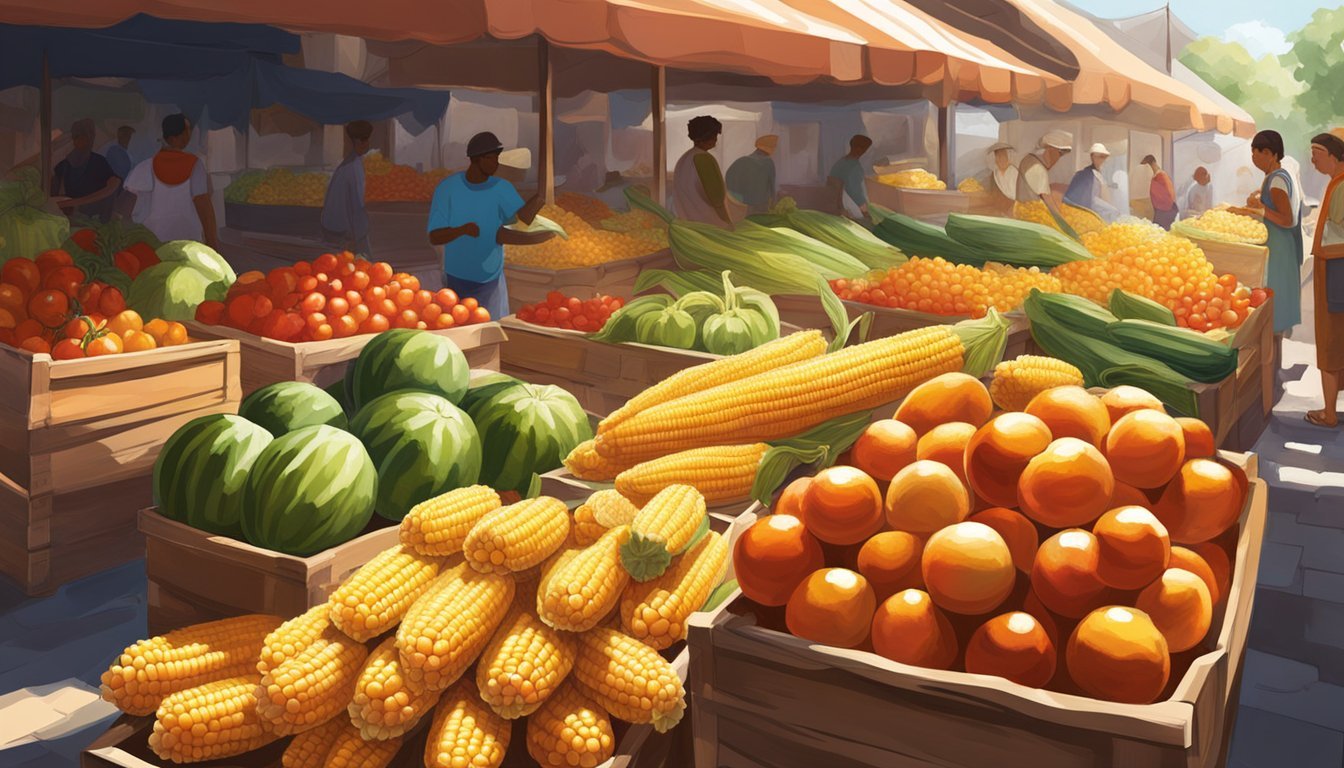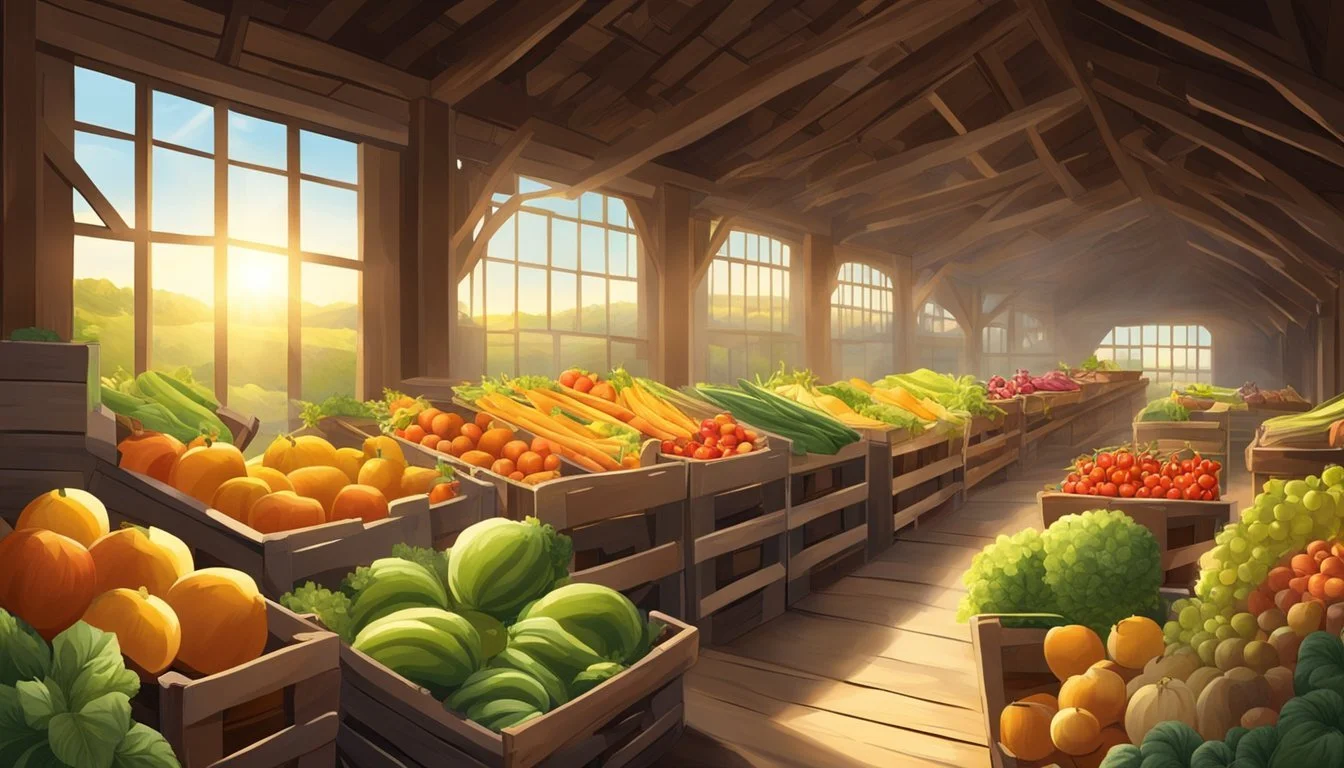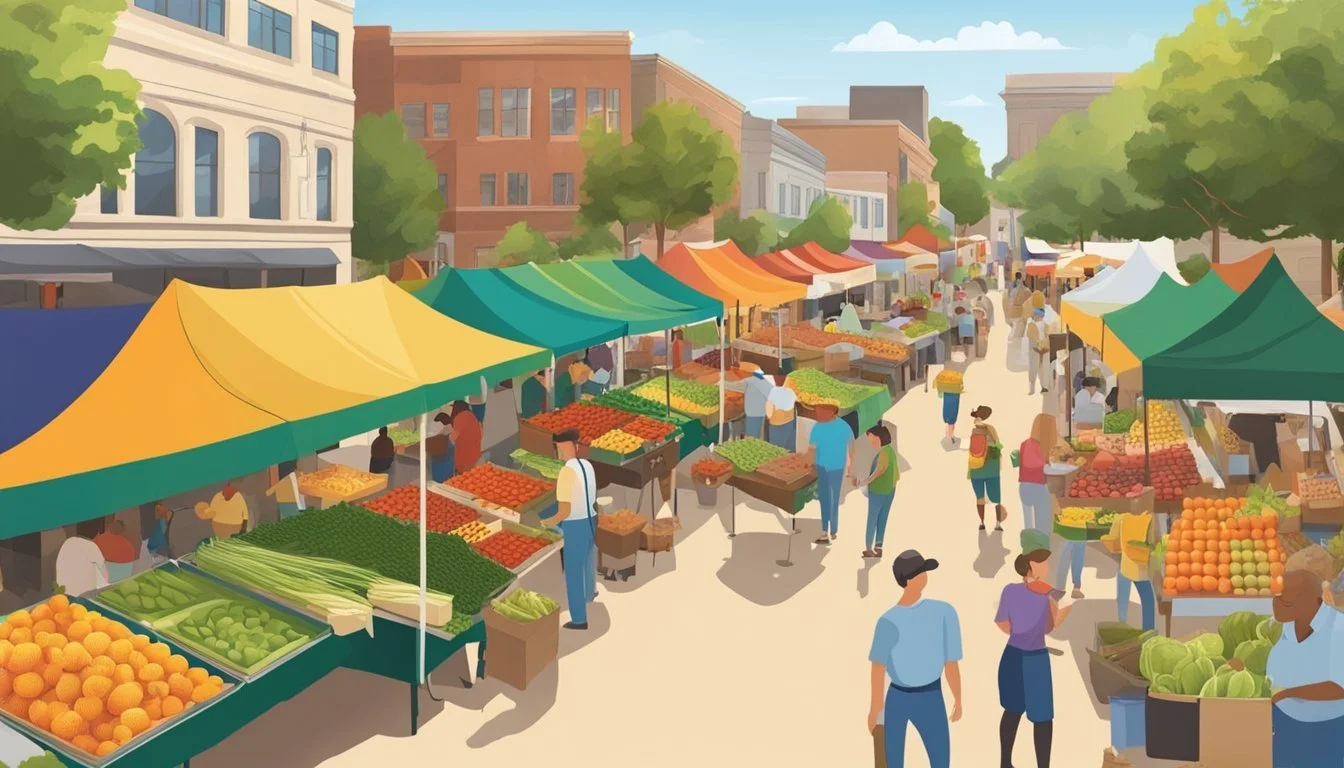Nebraska Seasonal Fruit & Vegetables in August
Your Fresh Guide
This Article is Part of our Nebraska Seasonal Fruit & Veg Calendar
August in Nebraska is a time of bounty in terms of fresh produce. The warm summer temperatures and long days have brought a wealth of fruits and vegetables to their peak, offering flavors that are unmatched by out-of-season counterparts. Shoppers have the opportunity to enjoy a diverse selection of fresh, locally-grown produce, which not only supports local farmers but also provides the unmatched taste of freshly harvested fruits and vegetables.
The list of fruits available in Nebraska during August is tantalizing, with tree-ripened apples in several varieties offering crisp, sweet flavors. Whether one prefers the tangy taste of a Blushing Golden or the honeyed crispness of a Fuji, Nebraska’s apple orchards are a treasure trove of these popular fruits. Apricots, another summer favorite, provide a soft, sweet option for both snacking and culinary uses.
Vegetables also flourish during this month, ready to be picked and enjoyed in their freshest form. From leafy greens to a multitude of squash varieties, Nebraska’s soil yields a rich harvest. These vegetables are not only flavorful but also brimming with nutrients. Local farmers markets and grocery stores are filled with vibrant produce, making August an ideal time for Nebraskans and visitors to embrace the state's agricultural abundance.
Understanding Nebraska's Growing Season
In August, Nebraska is in the midst of its productive growing season. This period is characterized by the harvest of summer crops and the preparation for fall planting. The state's hardiness zones predominantly range from 4b to 5b, with some areas extending into zone 6, influencing not only what can be grown, but when it should be planted and harvested.
Summer Squash, among other vegetables, thrives in Nebraska's August climate. Given the right soil conditions—a well-draining, fertile ground—summer squash can be harvested throughout the summer months, often continuing into the early fall.
The state typically experiences a full spectrum of weather conditions, and gardeners must be vigilant. Soil moisture levels can be drastically affected by drought or extreme heat, both common in Nebraska's summers. Gardeners often use strategies to retain soil moisture and protect plants during the hottest parts of the season.
Here's a quick glance at Nebraska's August planting and harvesting guide:
Harvesting:
Vegetables: Summer squash, tomatoes (What wine goes well with tomatoes?), peppers
Fruits: Melons, berries
Planting:
For fall harvest: Beets (how long do beets last?), carrots, kale
Planting a Garden: Those starting a garden in August must take care to select crops that can mature before the first frost dates, which can occur as early as October in some parts of the state.
As fall approaches, temperature drops will require Nebraskans to be attentive to their gardens, prepping for the transition from the warmth-loving summer crops to the more hardy, cool-season varieties.
Fruit Varieties Available in August
In August, Nebraska's fields and orchards brim with a vibrant variety of fruits. These seasonal offerings can be found at local farmers markets, boasting peak freshness and flavor.
Stone Fruits
Peaches, plums, and nectarines reach their peak in August. They are known for their juicy flesh and sweet flavors. It's important to select these fruits when they're ripe and fragrant to experience their full potential.
Peaches: Look for a well-defined crease and a fragrant aroma.
Plums: Choose plums that feel heavy for their size and have a slight give.
Nectarines: Similar to peaches in their aroma and should have smooth, unblemished skin.
Berries
Berry varieties are still thriving in August, with blackberries (how long do blackberries last?), blueberries (how long do blueberries last?), and raspberries being particularly noteworthy. These berries are packed with vitamins and are highly versatile in the kitchen.
Blackberries: They are large and dark when at their ripest.
Blueberries: Select blueberries that are firm, dry, and have a uniform hue.
Raspberries: Ripe raspberries are plump and pull away easily from the stem.
Melons
Watermelons and cantaloupes(how long does cantaloupe last?) are summer's refreshing treats. They are heavy with water content and offer a cooling respite during August's warm days.
Watermelons: A ripe watermelon will have a creamy yellow spot where it rested on the ground.
Cantaloupes: These should have a netted rind and yield a sweet aroma at the stem end.
Nebraska's August fruit selection provides a perfect opportunity for individuals to support local growers by purchasing at farmers markets and enjoying the state's seasonal bounty.
Seasonal Vegetables in Nebraska
In Nebraska, August is a time for a bountiful harvest of diverse vegetables. This season brightens up local markets with a gorgeous palette of produce rich in nutrients and flavors.
Leafy Greens
August in Nebraska sees a variety of leafy greens reaching their peak. One can find fresh kale and spinach, which are perfect for salads and smoothies. Swiss chard, with its colorful stems, also makes for a nutritious addition to any meal.
Kale
Spinach
Swiss chard
Root Vegetables
The soil of Nebraska nurtures a range of root vegetables during this month. Crisp and earthy carrots, juicy beets, and sharp radishes are in abundant supply. They are great raw or can elevate the taste of cooked dishes.
Carrots
Beets
Radishes
Nightshades
Nightshades thrive in the August warmth. Juicy tomatoes, ranging from cherry to beefsteak varieties, are at their most flavorful. Eggplants (What wine goes well with eggplant?) boast a glossy purple skin and spongey texture, suitable for a variety of dishes. Gardeners and farmers also harvest a colorful array of peppers, from sweet to hot, to spice up their cooking.
Tomatoes
Eggplants
Peppers
Other Popular Vegetables
There's no shortage of other popular vegetables. You'll find cucumbers (how long do cucumbers last?), crisp and refreshing for salads. Ears of corn are sweet and tender, a staple for many Nebraskan tables. Squash and zucchini (What wine goes well with zucchini?) are versatile for both baking and grilling. Broccoli, lettuce, and cabbage are other staples, while beans and peas provide a fresh, leguminous twist to any dish.
Cucumbers
Corn
Squash
Zucchini
Broccoli
Lettuce
Cabbage
Beans
Peas
Harvest and Storage Tips
August in Nebraska ushers in a bounty of fruits and vegetables ripe for the picking. Knowing when to harvest and how to store this produce properly ensures maximum freshness, longevity, and flavor for consumers and home gardeners alike.
Picking the Right Time to Harvest
Fruits: They, such as tomatoes, apples, and blackberries, should be harvested when fully ripe, as they do not continue to ripen substantially after picking. Vegetables like zucchini and cucumbers are best when picked young and tender for the best taste and texture.
Tomatoes: Wait until they are fully colored and slightly soft to the touch.
Apples: Look for full color development and taste for sweetness.
Cucumbers: Harvest when bright green and firm, before seeds become hard.
Zucchini: Small to medium-sized are usually more flavorful and less fibrous.
Timing: Harvesting in the morning tends to result in crisper, more hydrated produce. For those storing or preserving the harvest, consider:
Freezing: Ideal for berries and bell peppers.
Canning: Suitable for tomatoes and cucumbers.
Drying: Recommend for herbs and sturdy vegetables like corn.
Proper Storage Methods
Different produce requires varying storage techniques to preserve their quality:
Cold Hardy Vegetables: Store in a cool, humid place. They include root vegetables and hardy greens.
Fruits and Tender Vegetables: Maintain slight moisture but avoid sogginess. These should often be refrigerated to extend freshness.
Herbs: They can be either tied in bunches and hung to dry or frozen in ice cube trays with water.
Recipes: To make the most of the season's harvest, use freshly picked produce in recipes immediately or utilize proper storage methods if saving for future culinary use.
Specific storage techniques by type:
Root Vegetables (e.g., carrots, beets)
Store in a cool, humid environment like a root cellar or a perforated plastic bag in the refrigerator.
Leafy Greens (e.g., spinach, kale)
Keep in the crisper drawer of the refrigerator wrapped in paper towels.
Fruits (e.g., apples, blackberries)
Most fruit should be refrigerated; apples can be stored in a cool, dark place, while blackberries should be consumed quickly or preserved through freezing or canning.
Preparing Nebraska Produce
When dealing with fresh Nebraska produce in August, one has a bounty of options, from simple culinary applications to preservation techniques. Each method can maximize the flavor and nutritional benefits of the season's offerings.
Simple Recipes and Uses
The abundant August harvest in Nebraska allows for a plethora of simple recipes that bring out the natural flavors of the produce. Tomatoes, for example, can be sliced and seasoned with a sprinkle of salt and a drizzle of olive oil for a refreshing salad. Blackberries and other berries might be used in fruit salads or smoothies to provide a rich source of antioxidants with minimal preparation.
Sample Recipes:
Tomato Salad: Combine sliced tomatoes, basil, mozzarella, balsamic vinegar, and olive oil.
Blackberry Smoothie: Blend blackberries, plain yogurt, honey, and ice cubes for a quick, nutritious drink.
Preservation Techniques
Preserving the excess of Nebraska's August produce ensures that one can enjoy it well beyond the growing season. Techniques such as canning, drying, and freezing are effective means to extend the shelf life while retaining nutritional benefits.
Canning: Use a pressure canner for vegetables like green beans to ensure safety. Tomatoes can be canned using a water bath canner due to their acidity.
Drying: Fruits such as plums can be dried in a dehydrator or oven, providing a shelf-stable, nutrient-dense snack.
Freezing: Berries can be frozen on a baking sheet before being transferred to a container, which prevents them from clumping together and preserves their shape and nutritional value.
Gardening Tips for Local Species
Successful gardening in Nebraska requires understanding the climate's demands and tackling local pests and diseases head-on. Gardeners should make informed decisions about the species they grow and the methods they employ to ensure a robust and healthy garden.
Selecting the Right Variaries for Nebraska's Climate
Choosing plant varieties that are tailored to Nebraska's climate is crucial. Gardeners seek out cold-hardy species that can withstand the state's cooler fall months, as well as varieties that can manage occasional drought conditions. Lettuce is a prime example, with varieties like Butterhead and Loose Leaf flourishing in the fall and even during light snow or frost. Apple trees are also a good selection, particularly the popular 'Golden Delicious', 'Red Delicious', and 'Granny Smith', which are resilient in the shifting spring and fall temperatures.
Cold Hardy Varieties: Lettuce (Butterhead, Boston, Loose Leaf)
Drought Tolerant: Certain native species and adapted varieties
Perfect for Small Spaces: Dwarf apple tree varieties
Great for Vertical Gardening: Climbing beans
Dealing with Pests and Disease
Insects can turn a thriving garden into a struggling one. Nebraska gardeners often face pests like aphids, which can be managed through organic gardening practices such as introducing beneficial insects or using insecticidal soap. Disease control is equally important. Regularly cleaning up fallen leaves, especially from roses and peonies, can prevent diseases and insects from overwintering in the garden debris.
Insect Pests: Aphids, fall webworms
Organic Solutions: Introducing beneficial insects, insecticidal soaps
Disease Prevention: Removal of fallen leaves to minimize fungal spores and harboring of pests
By selecting the right plant varieties and employing effective pest and disease management strategies, Nebraska gardeners can enjoy a thriving, low-maintenance garden throughout the season.
Local Food Movements and Farmers Markets
In Nebraska, local food movements focus on connecting consumers directly with farmers through farmers markets and Community Supported Agriculture programs. These initiatives provide access to fresh vegetables and seasonal produce while supporting the state’s agricultural community.
Finding Local Produce
Farmers markets in Nebraska are prime locations for finding fresh, locally-grown produce. As of the most recent data, the state boasts a substantial number of farmers markets, with a concentration in counties such as Lancaster. During August, these markets are vibrant with seasonal offerings. Patrons can expect to find:
Fruits: Peaches, plums, and melons
Vegetables: Tomatoes, corn, cucumbers, zucchini, and peppers
Visitors not only have the opportunity to purchase fresh produce but also to engage with local farmers, gaining insight into where and how their food is grown.
Community Supported Agriculture (CSA)
Community Supported Agriculture, or CSA, is a partnership between local residents and farmers where consumers purchase a "share" of the season's harvest. In Nebraska:
CSA Shares: These often include a variety of vegetables and fruits available in August.
Support Local: Shareholders support their local farmers and receive regular allotments of fresh, seasonal produce throughout the growing season.
A CSA is a flourishing part of the community food movement, fostering a closer relationship between consumers and their food sources and ensuring support for farmers throughout the state.








